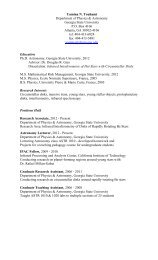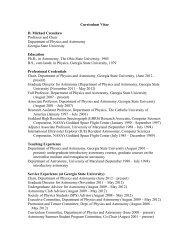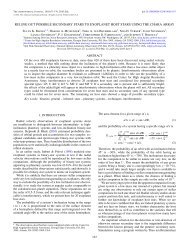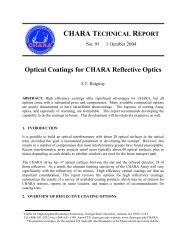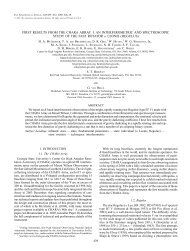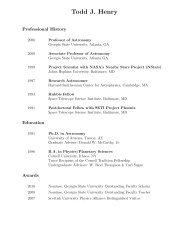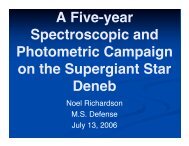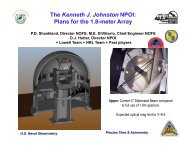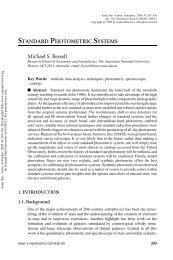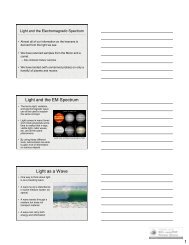Adaptive Optics Photometry and Astrometry of Binary Stars. II. A ...
Adaptive Optics Photometry and Astrometry of Binary Stars. II. A ...
Adaptive Optics Photometry and Astrometry of Binary Stars. II. A ...
Create successful ePaper yourself
Turn your PDF publications into a flip-book with our unique Google optimized e-Paper software.
546 ROBERTS, TURNER, & TEN BRUMMELAARVol. 133TABLE 1B Star BinariesHD WDS Discovery Hipparcos Besselian(arcsec) a(deg) bI3369................................... 00369+3343 RBR 3 Aab 2912 2001.7424 0.20 265.1Z/97.6N 8.7 1.8 c5394................................... 00567+6043 BU 1028 AB 4427 2002.6845 2.07 259.0 6.85 0.1823862................................. 03492+2408 RBR 4 Aab 17851 2002.0924 4.66 221Z/119N 9.4 0.5 c37711................................. 05413+1632 BU 1007 26777 2001.0985 0.26 221.2 1.51 0.03 d44458................................. 06214 1146 STF 3116 AB 30214 2003.9873 3.90 22.7 3.69 0.01100600............................... 11347+1648 STF 1552 AB 56473 2002.2407 3.41 205.8 1.41 0.01106625............................... 12158 1733 RBR 5 AB 59803 2002.2408 1.06 96.8 7.1 1.0 c120198............................... 13466+5426 RBR 6 Aa 67231 2002.2410 2.42 115.9 10.1 1.0 c135742............................... 15170 0923 RBR 7 AB 74785 2002.2411 2.09 194.2 8.8 0.5 c157039............................... 17227 3748 B908 AB 85020 2001.4686 2.71 114.5 6.0 0.1 e164863............................... 18042 2230 B1975 BC ... 2001.6710 0.47 236.0 4.90 0.30 e2002.6729 0.47 235.5 4.65 0.22164906............................... 18044 2423 RBR 8 AB ... 2001.6710 3.14 318.3 8.04 0.37 c170938............................... 18326 1542 RBR 9 AB 90907 2001.7364 7.31 250.2Z/218.1N 7.23 0.22 c171432............................... 18356 1833 RBR 10 AB 91143 2002.5474 4.86 320.0 10.6 0.5 c174638............................... 18501+3322 RBR 11 Aa 92420 2002.6731 0.54 176.3 4.53 0.20 c183914............................... 19307+2758 RBR 12 Ba 95951 2002.6842 0.39 107.5 4.12 0.17 ca Errors in this column are 0.02 00 for 1 00 , 0.01 00 for 1 00 < 4 00 , <strong>and</strong> 0.02 00 for >4 00 .b The position angles all have an error <strong>of</strong> 2 .c New discovery.d This measurement was made using the 700Y1060 nm filter.e Confirmation observation.An observing list <strong>of</strong> observable B stars was compiled from theSIMBAD database. 2 <strong>Stars</strong> were chosen so that they had zenithangles <strong>of</strong> 45 (declinations from 24.3 to +65.75 ) <strong>and</strong> werebrighter than 9 mag in the V b<strong>and</strong>. The brightness limit was chosenbecause the AEOS AO system has a limiting magnitude <strong>of</strong> approximately9 mag, although the exact limit depends on atmosphericconditions. This created a list with 3113 stars. In the endwe observed 70 stars, or 2.2% <strong>of</strong> the available stars. The smallpercentage <strong>of</strong> the available targets that were observed limits theamount <strong>of</strong> statistical analysis that can be applied the sample.The AEOS AO system is a natural guide star system using aShack-Hartmann wave front sensor (Roberts & Neyman 2002).The individual subaperatures have a diameter <strong>of</strong> 11.9 cm projectedonto the primary. The deformable mirror has 941 actuators.The system’s closed-loop b<strong>and</strong>width is adjustable <strong>and</strong> can run upto 200 Hz, although the normal range is approximately 50 Hz.In the configuration used for these observations, the light from 500to 540 nm is sent to the tip-tilt detector system, the light from 540to 700 nm is sent to the wave front sensor, <strong>and</strong> the light longer than700 nm is sent to the Visible Imager CCD science camera.Each data set consists <strong>of</strong> 1000 frames using a Bessel I-b<strong>and</strong>filter. After collection, any saturated frames are discarded, <strong>and</strong> theremaining frames are debiased, dark-subtracted, <strong>and</strong> flat-fielded.The frames are weighted by their peak pixel, which is proportionalto their Strehl ratio, <strong>and</strong> then co-added using a shift-<strong>and</strong>-add routine.The resulting image is analyzed with the program fitstars;ituses an iterative blind deconvolution that fits the location <strong>of</strong> deltafunctions <strong>and</strong> their relative intensity to the data. The co-addingtechnique <strong>and</strong> the analysis with fitstars were first presented in tenBrummelaar et al. (1996). Upgrades to fitstars were discussed inten Brummelaar et al. (2000) <strong>and</strong> Roberts et al. (2005).Error bars on the astrometry <strong>and</strong> photometry were assignedusing the method in Roberts et al. (2005). For the photometry,simulated binary stars were created from observations <strong>of</strong> singlestars. The photometry <strong>of</strong> these simulated binaries was measured2 The SIMBAD database can be found at http://simbad.u-strasbg.fr.<strong>and</strong> used to create a grid <strong>of</strong> measurement errors as a function <strong>of</strong>separation <strong>and</strong> differential magnitudes. For astrometry, the separationerror bar is 0.02 00 for 1 00 , 0.01 00 for 1 00 < 4 00 ,<strong>and</strong> 0.02 00 for >4 00 . In Roberts et al. (2005) we mistakenlyclaimed that the position angle error is a constant. This is not true;the error in position angle caused by errors in determining the centroid<strong>of</strong> the secondary star location is bigger for systems with smallseparations than for those with larger separations. We have adopted2 for 1 00 as our position angle error bar.3. RESULTSThe rest <strong>of</strong> the paper is laid out in the following way: first, wediscuss how we estimated a spectral type for any detected companions.Then we start discussing individual systems. We discussobservations <strong>of</strong> binaries for which we detected componentsthat are already known in x 3.2. Next, we discuss the detection <strong>of</strong>new components <strong>of</strong> binary systems in x 3.3. The astrometry <strong>and</strong>photometry for all binaries is shown in Table 1. Of course, we didnot detect companions to all the stars we observed. These aredescribed in Table 2. In x 3.5, we discuss binaries for which wedid not detect the previously known companions.3.1. Companion Spectral TypeFor stars where we detected another object in the field <strong>of</strong> view,we estimated the possible companion spectral type using the absolutemagnitudes <strong>of</strong> the MK classification in Cox (2000). There areonly data for luminosity classes V<strong>and</strong> I, so for luminosity classes IV<strong>and</strong> <strong>II</strong>I we used the main-sequence data, while for luminosityclasses <strong>II</strong> <strong>and</strong> I we used the supergiant data. We assumed that thecompanion was physically bound to the primary <strong>and</strong> was on themain sequence. If the primary is an unresolved binary, this willcontaminate the spectral type <strong>of</strong> the primary <strong>and</strong> cause an errorin the determination <strong>of</strong> the spectral type <strong>of</strong> the AO-resolvedcompanion. The results are discussed in the sections detailingthe individual stars.Admittedly this is a fairly crude way <strong>of</strong> spectral typing, but itis all that is available until multifilter observations are done. With



